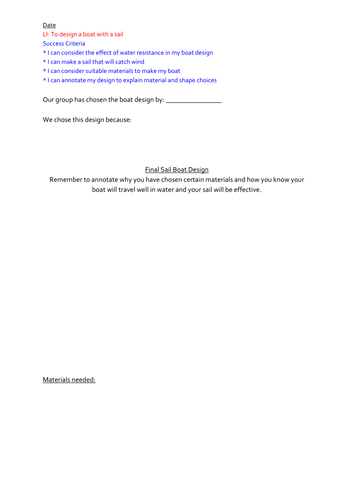


These two worksheets can expand to form a Science topic over four to five lessons.
Using their prior knowledge of materials and wind power, children independently design their own boat powered by wind either on paper or in their Science books. Existing examples could be shown.
Then, at the start of the next lesson, children would use the first worksheet in this resource to evaluate each others designs using the following criteria:
• Shape – How will this affect how it moves and balances on the water?
• Size – How will this affect how the boat floats and balances?
• Materials – Are they waterproof? How will you join them securely?
• Sail – How will it steadily stay up and move the boat forwards?
Following this, either in the same or next lesson, groups would then choose the best design or combination of design ideas from those on their table, to form a final group design of a boat with a sail.
On the second sheet in this resource, they would then work together to plan their final design, using the following criteria:
* I can consider the effect of water resistance in my boat design
* I can make a sail that will catch wind
* I can consider suitable materials to make my boat
* I can annotate my design to explain material and shape choices
Each group would draw their final boat design and list the materials needed to make it, before going on to make their boat in the following lesson, and then test them the lesson after that in a suitable outdoor location! (...we used a paddling pool!)
Using their prior knowledge of materials and wind power, children independently design their own boat powered by wind either on paper or in their Science books. Existing examples could be shown.
Then, at the start of the next lesson, children would use the first worksheet in this resource to evaluate each others designs using the following criteria:
• Shape – How will this affect how it moves and balances on the water?
• Size – How will this affect how the boat floats and balances?
• Materials – Are they waterproof? How will you join them securely?
• Sail – How will it steadily stay up and move the boat forwards?
Following this, either in the same or next lesson, groups would then choose the best design or combination of design ideas from those on their table, to form a final group design of a boat with a sail.
On the second sheet in this resource, they would then work together to plan their final design, using the following criteria:
* I can consider the effect of water resistance in my boat design
* I can make a sail that will catch wind
* I can consider suitable materials to make my boat
* I can annotate my design to explain material and shape choices
Each group would draw their final boat design and list the materials needed to make it, before going on to make their boat in the following lesson, and then test them the lesson after that in a suitable outdoor location! (...we used a paddling pool!)
Get this resource as part of a bundle and save up to 60%
A bundle is a package of resources grouped together to teach a particular topic, or a series of lessons, in one place.
Something went wrong, please try again later.
This resource hasn't been reviewed yet
To ensure quality for our reviews, only customers who have purchased this resource can review it
Report this resourceto let us know if it violates our terms and conditions.
Our customer service team will review your report and will be in touch.
£2.50